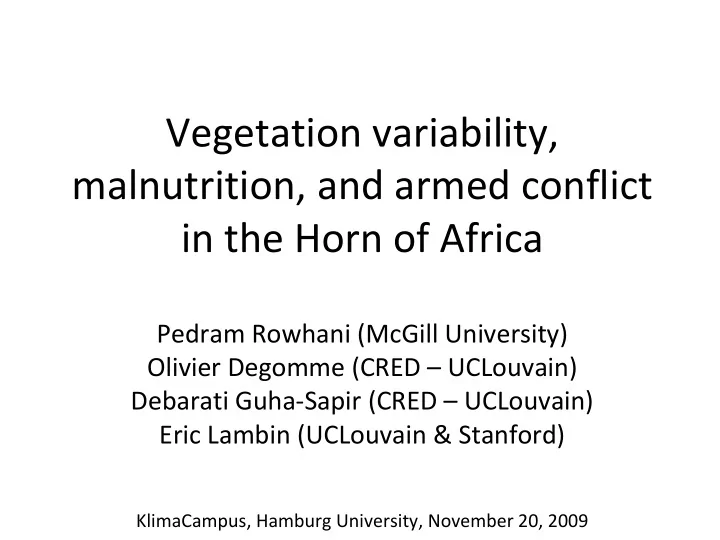

Vegetation variability, malnutrition, and armed conflict in the Horn of Africa Pedram Rowhani (McGill University) Olivier Degomme (CRED – UCLouvain) Debarati Guha ‐ Sapir (CRED – UCLouvain) Eric Lambin (UCLouvain & Stanford) KlimaCampus, Hamburg University, November 20, 2009
Climate change ‐ famine ‐ war
Study area • Sudan (states ‐ wilayat): Southern Sudan since early 1980’s; Darfur, war opposing nomad Arab militia to different local non ‐ Arab groups • Ethiopia (zones): The Ogaden province; Border dispute with Eritrea; Involved in insurgency in Somalia • Somalia (regions ‐ gobollada): No permanent national government 4 million km² supporting 56 million people 3 of the world’s poorest countries hit by conflicts and famines (> 6 million IDP)
Data Complex Emergency Database (CE ‐ DAT): Global Acute Malnutrition • (GAM) represents the proportion of children below 2 standard deviation from the average ratio weight ‐ over ‐ height • MODIS: Vegetation variability (SCV), production (iEVI), land degradation (decreases in iEVI) •Armed Conflicts database, version 3 ‐ 2005: Conflicts with at least 25 battle deaths/year, LAT/LONG and Radius • Gridded Gross Domestic Product (GDP) •Road density
Global Acute Malnutrition (GAM) The nutritional status of a population is one of the basic indicators to assess the severity of a humanitarian crisis. The weight and height of children between 6 and 59 months are measured and the results are used as a proxy indicator for the general health of the entire population. Global Acute Malnutrition (GAM) = weight ‐ for ‐ height index less than ‐ 2 standard deviations from the mean weight of a reference population of children of the same height and/or having oedema. Thresholds: <5% = acceptable 5% to 9.9% = poor 10% to 14.9% = serious >15% = critical
Remote sensing First day of data collected by MODIS on the TERRA platform
MODerate resolution Imaging Spectroradiometer (MODIS) • MODIS data – Geo ‐ location ~ 50 m – 250 – 1000 m resolution – Enhanced radiometric quality – Real ‐ time atmospheric correction – Designed for vegetation monitoring • MOD43B4 – Feb 2000 – DEC 2006 – 1 km resolution – 16 ‐ day composites – BRDF corrected reflectance products (Schaaf et al. 2002) Global MODIS Enhanced Vegetation Index ρ ρ nir red EVI G ρ ρ ρ C C L nir 1 red 2 blue
Vegetation variability (1) I 1 I 2 • Change Vector – Difference of annual profile vectors EVI Profiles CV I I 2 1 CV Change Vector
Vegetation variability (2) Sum of the absolute values of the Change Vector (SCV) n year ref I I SCV(year) i i i 1 • Changes in amount of EVI • Changes in phenology and/or timing of activity Linderman et al., 2005
Vegetation variability (3) Mean SCV 2000 ‐ 2006 period at 1km resolution (SCV/iEVI(ref))
Vegetation availability / Degradation integrated EVI Six year profile (iEVI) 4500 4000 3500 3000 EVI 2500 23 2000 iEVI EVI j 1500 j 1 1000 1 9 17 25 33 41 49 57 65 73 81 89 97 105 113 121 129 137 Time
Land degradation (iEVI)
Method Logistic regressions: 1.Malnutrition ~ f(Conflict) Administrative & 2.Malnutrition~f(SCV,iEVI,degradation,GCP,Roads) Village level 3.Conflict~f(SCV,iEVI,degradation,GCP,Roads)
Results (1) malnutrition ~ conflict In the Horn of Africa, GAM values over 15 are 11.7 times more likely to be found in conflict areas. Logistic regression model results measuring the relationship between GAM and conflict (pseudo ‐ R2 = 0.19, model chi ‐ square = 0.0008, area under ROC = 0.74, AIC = 46.506)
Results (2) Malnutrition • Regions with unpredictable vegetation productivity have an increased likelihood of acute malnutrition. • Malnutrition is 15.4 times more likely to be found in a poor area. • The likelihood of observing malnutrition decreases with road density. Variable Parameter estimate Standard error P-value Odds ratio admin. unit village admin. unit Village admin. Unit village admin. unit village Intercept 22.61 7.36 9.85 2.06 0.0217 0.0003 - - log 10 GCP -3.57 -0.87 1.36 0.258 0.0089 0.0007 0.0283 0.419 Roads -53.55 25.28 0.0341 5.5 · 10 -24 SCV 17.38 8.66 0.0446 3.55 · 10 07 Multivariate logistic regression model results analyzing the spatial distribution of conflict (pseudo ‐ R² = 0.23/0.04, area under ROC = 0.81/0.64)
Results (3) Armed conflict • Better economic situation reduces likelihood of armed conflict. • Armed conflicts are more likely in regions with more vegetation. • Interannual variability in vegetation and land degradation do not explain the presence of conflict in the Horn of Africa. Variable Parameter estimate Standard error P-value Odds ratio Admin. unit village admin. unit Village admin. unit village admin. unit village Intercept 7.235 2.108 4.08 2.63 0.0762 0.01 1387.06 8.23 log 10 GCP -1.089 0.548 0.0471 0.3366 iEVI 3.6 · 10 -05 5.73 · 10 -05 1.50 · 10 -05 1.16 · 10 -05 0.0163 8.04 · 10 -07 1.00004 1.00007 Multivariate logistic regression model results analyzing the spatial distribution of conflict (pseudo ‐ R2 = 0.08/0.13, area under ROC = 0.71/0.74)
Conclusions • Malnutrition and armed conflict are closely related • Direct association between interannual variability in vegetation productivity and malnutrition • Vegetation variability indirectly associated with conflict • Short ‐ term land degradation not related to malnutrition and armed conflict • Better economic situation found in peaceful areas with low levels of malnutrition (scale independent) • High vegetation production associated with conflict • Different processes at different scales • Data quality/availability!!!
Thank you! Pedram.rowhani ‐ ardekani@mcgill.ca
Recommend
More recommend